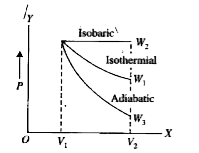A sample of gas expands from volume V1 to V2. The amount of work done by the gas is greater when the expansion is
Adiabatic
Equal in all cases
Isothermal
Isobaric
The correct Answer is:D
Step by step video & image solution for A sample of gas expands from volume V_(1) to V_(2). The amount of work done by the gas is greater when the expansion is by Physics experts to help you in doubts & scoring excellent marks in Class 12 exams.
Updated on:21/07/2023Topper's Solved these Questions
- THERMODYNAMICSBOOK - AAKASH INSTITUTE ENGLISHCHAPTER - THERMODYNAMICSEXERCISE - ASSIGNMENT (SECTION -D) (Assertion - Reason Type Questions)
10 Videos
- THERMODYNAMICSBOOK - AAKASH INSTITUTE ENGLISHCHAPTER - THERMODYNAMICSEXERCISE - ASSIGNMENT (SECTION -B) (Objective Type Questions)
30 Videos
- THERMAL PROPERTIES OF MATTERBOOK - AAKASH INSTITUTE ENGLISHCHAPTER - THERMAL PROPERTIES OF MATTEREXERCISE - Assignment (Section-J) Akash Challengers Questions
7 Videos
- UNITS AND MEASUREMENTSBOOK - AAKASH INSTITUTE ENGLISHCHAPTER - UNITS AND MEASUREMENTSEXERCISE - ASSIGNMENT (SECTION - D)
15 Videos
Similar Questions
A sample of gas expands from volume V1 to V2. The amount of work done by the gas is greatest when the expansion is
View SolutionStarting with the same initial conditions, an ideal gas expands from volume V1 to V2 in three different ways, the work done by the gas is W1 if the process is purely isothermal, W2 if purely isobaric and W3 if purely adiabatic, then
View Solution
Knowledge Check
Starting from the same initial conditions, an ideal gas expands from volume V1→V2 in three different ways. The work done by the gas is W1 if he process is purely isothermal, W2 if purely isobaric and W3 if purely adiabatic. Then
 AW2>W1>W3BW2>W3>W1CW1>W2>W3DW1>W3>W2
AW2>W1>W3BW2>W3>W1CW1>W2>W3DW1>W3>W2
An ideal gas is allowed to expand against a constant pressure of 2 bar from 10L to 50 L in one step. Calculate the amount of work done by the gas. If the same expansion were carried out reversibly, will the work done be higher or lower than the earlier case ?
(Give that, 1 L bar = 100 J)
View SolutionThe magnitude of ethalphy changes for reversible adiabatic expansion of a gas from volume V1 to V2(in L)is ΔH1 and for irreversible adiabatic expansion for the same expansion is ΔH2. Then
when ΔU1 and ΔU2 are the changes in magnitudes for the internal energy of gas in the two expansions.
View SolutionThe number of correct statements among the following
1 The expansion work for a gas into vacuum is equal to zero.
2. 1 mole of a gas occupying 3 litre volume on expanding to 15 litre at constant pressure of 1 atm does expansion work 1.215kJ.
3. The maximum work done by the gas during reversible expansionof 16g O2 at 300K from 5dm3 to 25dm3 is 2.0074 kJ.
4. The ΔSfor s→l is almost negligible in comparison to ΔS for l→g.
5. ΔS=2.303nRlogV2V1 (at constant T)
6. Reversible isothermal work done =−2.303nRTlog10V2V1
View SolutionA gas can expand from 100mL to 250mL under a constant pressure of 2 atm. The work done by the gas is
View SolutionFind the expression for the work done by a system undergoing isothermal compression (or expansion) from volume V1 to V2 at temperature T0 for a gas which obeys the van der waals equation of state. (P+an2/V2)(V−bn)=nRT?
View SolutionThe figures given below show different processes (relating pressure P and volume V) for a given amount of an ideal gas. W is work done by the gas and ΔQ is heat absorbed by the gas.

View SolutionA sample of ideal gas undergoes isothermal expansion in a reversible manner from volume V1 to volume V2. The initial pressure is P1 and the final pressure is P2. The same sample is then allowed to undergoes reversible expansion under adiabatic conditions from volume V1→V2. The initial pressure being same but final pressure is P3.
The work of expansion in adiabatic process (wadi) is related to work of expansion in isothermal process (wiso) is
View Solution
